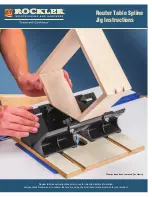
12
e) Routing with the SZ-OF 1000 beam compasses
With the SZ-OF 1000 beam compasses, which are available
as an accessory, you can make circular cuts or segments of
circles with diameters from 153 to 760 mm.
- The beam compasses are pushed into the front groove of
the platen until the desired radius is set.
- Lock the beam compasses with the rotating knob (8.1).
Practical hint:
To prevent the tip of the compasses from
making a hole in the workpiece, fix a thin board at the centre
point by means of double-sided adhesive tape.
b) Routing with the parallel guide
The parallel guide (6.8) supplied can be used for routing
parallel to the edge of the workpiece.
- Clamp the two guide rods (6.6) to the parallel guide with the
rotary knobs (6.3).
- Push the guide rods into the grooves (6.2) of the router table
until the desired distance between the router and workpiece
edge is reached. Clamp the guide rods tight with the rotary
knobs (6.1).
This distance can be adjusted faster and more precisely with
the fine precision adjustment (6.7), available as an accessory.
- Turn the adjusting screw (6.4) in the plastic part of the guide.
- Clamp the guide rods with the rotating knobs (6.5) in the
precision adjustment.
- Loosen the rotating knobs (6.3) of the parallel guide, set the
desired distance with the adjusting screw and retighten the
rotating knobs.
c)
Routing with the TV-OF extension table
The extension table TV-OF, available as an accessory, can be
used to enlarge the support area of the router and thus
improve guidance, e.g. when routing close to edges. The
extension table is fitted in the same way as the parallel guide.
d) Routing with the FS guide system
The guide system, available as an accessory, facilitates routing
straight grooves.
- Fasten the guide stop (7.1) to the platen with the guide rails
(7.3) of the parallel guide.
- Fasten the guide rail (7.5) with FSZ screw clamps (7.4) to
the workpiece. Make sure that the safety distance X of 5 mm
between the front edge of the guide rail and cutter or groove
is observed.
- Place the guide stop onto the guide rail as shown in Fig. 7. To
ensure a backlash-free guidance of the router stop you can
adjust two guide cheeks with a screwdriver through the side
openings (7.2).
- Screw the height-adjustable support (7.7) of the router tables
threaded bore in such a way that the underside of the router
table is parallel to the surface of the workpiece.
When working with marking-up lines, the marks on the platen
(7.6) and the scale on the support (7.7) show the centre axis
of the cutter.
4.3 Working with the router
Always switch the router on first before bringing the tool into
contact with the workpiece!
Always advance the router in the direction
opposite to the direction of rotation of the cutter (counter-
routing)!
a) Freehand routing
Freehand routing is the method normally used for lettering or
shapes, and for routing edges using cutters with a guide pin
or ring.
Содержание 1010 EQ
Страница 20: ...20 ...






































